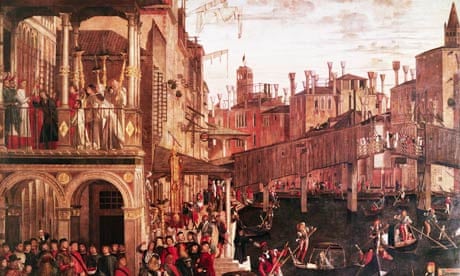It's only a bend in the river, but the former painter Orhan Pamuk offers such enticing prospects when he writes about the visual arts that I couldn't help stopping for a moment to reflect on the view.
The second of his Norton lectures, published earlier this year as The Naive and The Sentimental Novelist, begins with a return to his preoccupation with the novelist's contradictory stance – the dual insistence that it is all made up, but that it is nevertheless convincingly real. But it's an aside about the way the "art of the novel ... has rapidly become the dominant literary form" which caught my eye.
This process can be likened to the way the art of painting that developed during the Renaissance, an art based on perspective, established a dominant position (aided by the invention of photography and the craft of reproduction) across the entire world within the space of four centuries. Just as the way a handful of fifteenth-century Italian painters and aristocrats saw and depicted the world is now accepted everywhere as the norm, replacing other ways of seeing and depicting, so the idea of fiction disseminated by the novel and popular cinema has been accepted around the globe as a natural thing ...
Pamuk paints the triumph of perspective in the visual arts as a kind of accident here, a whimsical choice which makes the decline of compositions organised by spiritual or thematic importance a matter of fashion. But surely the global victory of the techniques pioneered by Brunelleschi and Giotto has been possible because they embody a brute fact about the world we live in – that light travels in straight lines – a fact which underpins those technologies of capture and reproduction mentioned only in parentheses.
So if perspective's contemporary dominance is based on a technological breakthrough, can the same be said of the novel?
Like many before him, Pamuk suggests that Shakespeare did much to shape the modern conception of character as embodying more than "a single, basic attribute", offering instead protagonists who are complex entities "shaped by conflicting impulses and conditions". But it is the novel, with its privileged access to its characters' private experience, with its unique ability to immerse the reader in a world seen "through the eyes of one of the figures in the story", which puts these conflicts at its heart.
Does the way the novel is constructed from the ebb and flow of its characters' inner lives capture something of human existence, just as pictures composed according to the rules of perspective capture something about the relationship between object and viewer? The idea that our selves are determined once and for all by the circumstances of our birth, that life should be lived in straightforward obedience to faith and duty, with the struggle for personal fulfilment and self-expression put painlessly to one side, seems as remote to us now in the comfortable west as Homer's portrayal of Odysseus as a man embodying one essential quality, a man who for Pamuk "despite moments of fear and indecision ... is always great-hearted".

Comments (…)
Sign in or create your Guardian account to join the discussion